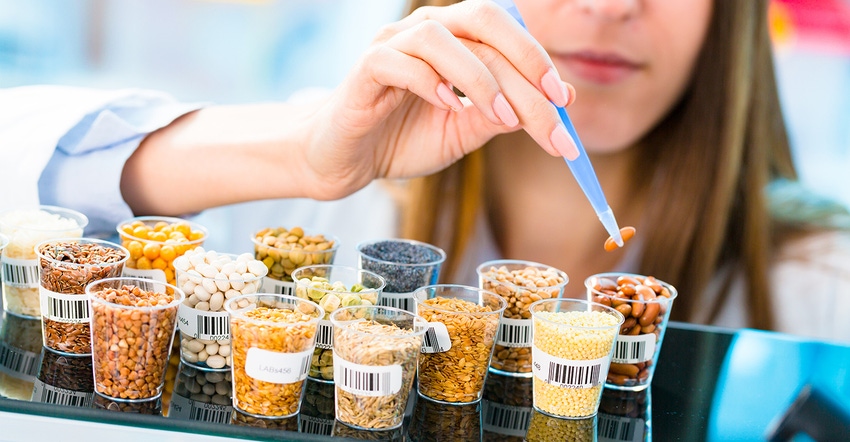Breaking down the GMO debate
GMOs have become ubiquitous over the previous three decades due to agriculture benefits, but many consumers are uninformed of their advantages.

More than 90% of cotton, soy and corn grown in the United States is now of the genetically modified (GM) variety, and more than 95% of food-producing animals consume GM feed.1 Beginning with the FLAVR SAVR™ tomato—modified for a longer shelf life—in 1994 and now encompassing a range of mostly herbicide- and pest-resistant crops, GMO (genetically modified organism) foods have been taking over grocery stores and farms for decades.
This class of foods went from novel to ubiquitous in a short time, but is still poorly understood by many consumers. This has resulted in a counter-movement promoting “non-GMO” foods, even while many brands see the benefits—and even necessities—of using GMO ingredients in their products.
To understand the GMO debate, one must understand GMOs. GMOs are what they sound like: organisms with DNA modifications through genetic engineering. While this may induce thoughts of “Frankenfoods,” the reality is that most of these modifications are imperceptible to the end consumer. Most genetic modification of foods results not in altered nutritional value or flavor, but rather resistance to weed-controlling herbicides and crop-destroying pests. The result is food products that look, taste and essentially are identical to their conventional counterparts, but are easier to grow. These modifications, according to most scientists, pose no risk to human health, and all GMO foods are tested before reaching consumers per federal regulations.
The American Association for the Advancement of Science (AAAS) agrees. In 2012, its board of directors published a statement saying, “Indeed, the science is quite clear: Crop improvement by the modern molecular techniques of biotechnology is safe.”
The adoption rate of GMO crops highlights the benefits of growing them. From 1996 to 2014, herbicide-resistant soy expanded from 7% of all U.S. soy acreage to 94%; for cotton, that number rose from 2% to 91%; for corn, from 3% to 89%.1 The same trend holds true for insect-resistant (or Bt) crops. Bt corn acreage expanded from 1 percent to 80 percent in the United States from 1996 to 2014; Bt cotton expanded from 15% to 84%. Clearly, farmers have taken to these modified crops.
It’s obvious that GMO crops have become industry standard, so the natural follow-up question is, why? For farmers, the answer is yield. Insects account for a loss of nearly one-third of traditional crops; weeds account for another 10%.2 Therefore, crops resistant to these forces suffer considerably fewer losses. Crops resistant to either insects or herbicides yield, on average, 10% more than crops that are not. Crops resistant to both see an increase of 20 to 25%. This has a direct effect on profits; farmers’ profits rose by an average of 68% when switching to GMO crops.3 To put that in dollar figures, economic benefit at the farm level was estimated at US$18.8 billion in 2012.
That cost benefit trickles down to consumers. It is estimated that prices for corn, soybeans and another popular GMO, canola, are lower by 5.8, 9.6 and 3.8%, respectively, than if GMO crops were unavailable.3
Benefits of GMO
The benefits of GMO crops extend beyond dollars. The environmental impact has been positive overall.
An assessment of the environmental impact of GMO crops from 1996 to 2015 makes this clear. According to agricultural economists Graham Brookes and Peter Barfoot, “Aggregate reductions in both the volume of herbicides used … and the associated field [environmental impact quotient] values when compared with usage on conventional (non-GMO) crops … [indicated] net improvements to the environment.”4
According to their research, despite a small net increase in herbicide active ingredient (HAI) use on soy crops (an increase of 0.5%), there was an environmental impact quotient (EIQ) improvement of 13.9% in those areas due to the use of more benign herbicides. For corn, HAI use dropped 8.4% and EIQ improvement was 12.7%. For cotton, the reduction in HAI was 7.6%, while the EIQ improvement was 10.2%.
EIQ scores consider only the impact of changes in pesticide use, but GMO environmental benefits extend to greenhouse gas emissions as well. A reduction in pesticide use means fewer spray runs, which means less fuel being used to make those runs. According to Brookes and Barfoot, this resulted in a permanent reduction of carbon dioxide in the atmosphere from 1996 to 2015 equivalent to taking 11.65 million cars off the road for a year. GMO crops have also allowed for the switch to reduced or no-tillage (RT/NT) farming, which reduces the amount of carbon dioxide from the soil that is released into the atmosphere. This switch to RT/NT systems reduced carbon dioxide in the atmosphere by 227 million tons since 1996.
It’s no surprise that Omri Ben-Shahar, law professor at the University of Chicago, said, “There is no other policy that a true environmentalist should support more vigorously than the transition of the rest of the world to GMO-based agriculture.”2
This doesn’t mean GMOs don’t come with their share of controversy and pushback from various groups and individuals who see genetic modification of food to be unnatural and unsafe. In addition, environmental and societal concerns extend beyond the safety of the end product.
Brooks and Barfoot noted that, in areas where herbicide (specifically, glyphosate) resistant crops are grown, harmful weed resistance has followed. Others, including the Non-GMO Project—a non-governmental organization dedicated to proper labeling of GMO and non-GMO foods—and Greenpeace, objected to the potentially unforeseen ramifications—"unpleasant surprises,” as the Non-GMO Project says—of introducing GMOs into the wild. There is also legitimate concern about the intellectual property (IP) of GMOs, where corporations such as Monsanto own—and therefore control the distribution of—GMO seed.
Some extreme outlier events have gained considerable media attention, including the 2000 StarLink corn recall and potential links between the rise of GMOs and the decline in monarch butterfly populations.
Arguments against GMOs
For the most part, other arguments against the use of GMOs are more related to perceived or theoretical issues than tangible ones.
The Non-GMO Project calls GMOs “unnatural” and “weird.” Their website also stated that “In the absence of credible independent long-term feeding studies, the safety of GMOs is unknown.” While it is true that, given the relative infancy of GMO crops, few long-term studies exist, scientific consensus is that GMO foods are safe.
Of course, that doesn’t mean the demand for non-GMO foods doesn’t exist. On the contrary, non-GMO food options are on the rise, if recent data from New Hope Network NEXT Trends Database is any indication. When comparing data from Natural Products Expo West 2018 with the same event three years prior, it becomes clear that foods with non-GMO claims and certifications are only increasing.
In 2015, products with a “non-GMO” claim accounted for 22% of all products at Expo West; that number increased to 27% in 2018. For products with a “non-GMO” certification, the increase was even more dramatic; products with non-GMO certification increased from 16% of all products in 2015 to 23% in 2018.
The scientific community reached a consensus on the benefits and safety of GMOs. Groups like the Non-GMO Project and Greenpeace are determined in their opposition. But the public is split on the issue, thanks largely to both a lack of knowledge on the subject and confusion on whom to trust to inform them.
A 2016 poll conducted by the Pew Research Center highlighted just how split and uncertain Americans are with regard to GMOs. According to Pew research, despite 88% of AAAS scientists believing GMO foods are safe to eat, just 37% of the public agrees.5
Perhaps this view of GMO foods as unsafe explains why, from 2015 to 2018, baby food with a non-GMO certification saw share growth of 934% among all products with a non-GMO certification. If just 37% of Americans believe GMO foods to be safe, it only makes sense that most would look for non-GMO alternatives for their young children.
Additionally, 48% of respondents believe they do not eat any foods containing GMOs. As the Pew researchers pointed out, “the argument goes that people who see themselves as not eating GM foods must be largely unaware that much of today’s food supply contains at least some GM ingredients.” By that logic, nearly half of all Americans are unaware of that fact.
Given this general lack of awareness regarding GMOs, it should come as little surprise that Americans are divided when it comes to the perceived risks and benefits associated with them. Thirty-nine percent of Americans believe GMOs to be worse for one’s health, and another 10% better for one’s health, neither of which is generally true.
What are brands to do?
With the public so divided—and generally uneducated—on the topic, it’s up to brands, experts, policymakers and the media to get the right information to as many people as possible. Unfortunately, the public is also unsure of whom to trust when it comes to GMOs.
Remember: 88% of AAAS scientists agree GMO foods are safe. But just 14% of the public believes that most scientists agree on this, with 53% believing that fewer than half of all scientists hold this view. Americans also aren’t sure that the scientific community is informed or trustworthy enough; just 19% believe scientists understand the health risks and benefits of GMOs “very well,” and just 35% trust scientists to give full and accurate information regarding GMOs.
This backs up the words of David Sutherland, co-founder of Vegan GMO, who says his views were once anti-GMO before he became more informed. As he put it:
“My anti-GMO opinions weren’t very well researched or detailed. They were more a visceral reaction. When I started learning more about the science behind it … I sort of realized that it’s not so much unnatural, it’s just a more precise way of doing things. Talking to a lot of scientists … about GMO technology … knowing more helped me fear it less.”
Americans also don’t believe the media is doing a good job presenting the issue; Pew research indicated that 56% of Americans believe the media does a somewhat or very bad job presenting the GMO debate. They also don’t trust the media on the subject; a majority (54%) of Americans trust the news media “not too much” or “not at all” on the subject.
All of this points to one clear conclusion: Americans don’t know which sources to trust when it comes to GMOs. Conflicts of interest and biases—whether real or perceived—have left Americans feeling like they have no one to trust when it comes to GMOs, which in turn leads to fewer science- and fact-based stances and more emotionally driven reactions to a topic few fully understand.
Or, as Sutherland put it, “It’s all visceral.”
Genetically modified organisms, and foods derived from them, can—like any new technology—be scary to the uninformed.
As the majority of available literature states, and the near-unanimous consensus of the scientific community echoes, the GMO foods currently available to consumers are safe. Despite even well-intentioned resistance from various individuals and groups, GMOs have proven to be safe and beneficial to both the environment and those who grow and consume them. The problem lies not with GMOs or the processes that create them, but rather with the lack of accurate information about them reaching the public. With proper regulation and oversight of their creation and distribution, and increased focus on educating consumers, GMO foods should not only be here to stay, but could continue to benefit future generations to come.
References:
1 Wunderlich, Shahla and Kelsey A Gatto. “Consumer perception of genetically modified organisms and sources of information” Advances in nutrition (Bethesda, Md.) vol. 6,6 842-51. 10 Nov. 2015, doi:10.3945/an.115.008870
2 Ben-Shahar, Omri. “The Environmentalist Case In Favor Of GMO Food.” Forbes, Forbes Magazine, 2 Mar. 2018, www.forbes.com/sites/omribenshahar/2018/02/26/the-environmentalist-case-in-favor-of-gmo-food/#34df991837de.
3 Lucht, Jan M. “Public Acceptance of Plant Biotechnology and GM Crops” Viruses vol. 7,8 4254-81. 30 Jul. 2015, doi:10.3390/v7082819
4 Brookes, Graham and Peter Barfoot. “Environmental impacts of genetically modified (GM) crop use 1996-2015: Impacts on pesticide use and carbon emissions” GM crops & food vol. 8,2 (2017): 117-147.
5 Funk, Cary, and Brian Kennedy. “Public Opinion about Genetically Modified Foods and Trust in Scientists.” Pew Research Center: Internet, Science & Tech, Pew Research Center: Internet, Science & Tech, 1 Dec. 2016, www.pewinternet.org/2016/12/01/public-opinion-about-genetically-modified-foods-and-trust-in-scientists-connected-with-these-foods/
About the Author(s)
You May Also Like






.png?width=800&auto=webp&quality=80&disable=upscale)